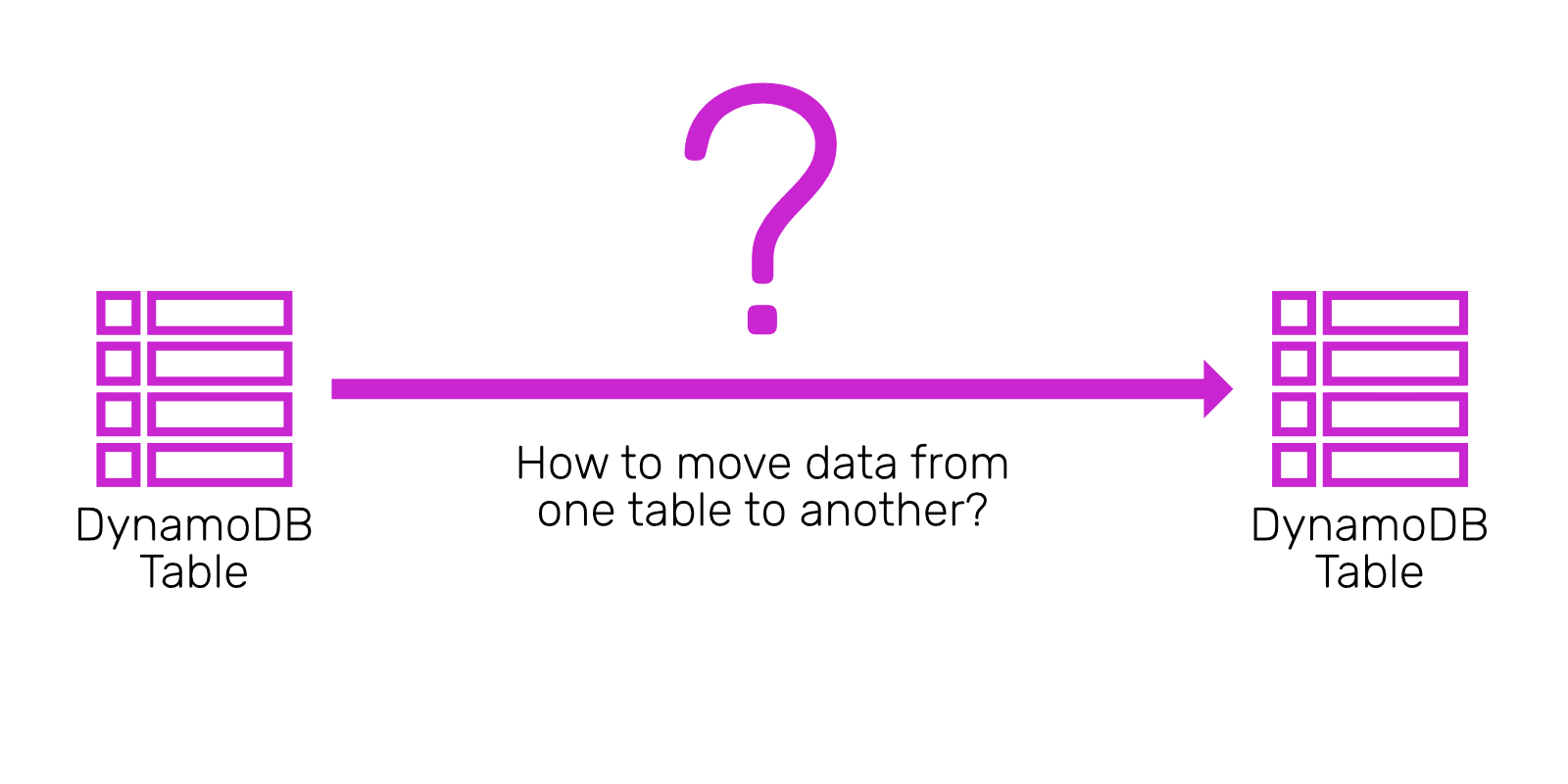How to move a DynamoDB table to another region or account?
How to move data from one DynamoDB table to another? For example, when it becomes necessary to move a DynamoDB table to another account or region.
In the following blog post, I will discuss three different options to move DynamoDB tables by backing up and restoring data. All three options work in harmony with Infrastructure as Code tools such as Terraform and CloudFormation. Be aware that a downtime is necessary for both options to avoid data loss.
- Restore table from backup
- S3 Export and Import
- Copy data with DynamoDB CLI tool
dynein

Backup and Restore
The first approach is to back up and restore a DynamoDB table. AWS provides two ways to do so:
- DynamoDB’s built-in backup and restore functionality
- AWS Backup service
Use the AWS CLI to create an on-demand backup of the source table demo-source with DynamoDB’s built-in backup and restore functionality.
$ aws dynamodb create-backup --table-name demo-source --backup-name snapshot |
After the backup is complete, the following command creates a new table based on the backup.
aws dynamodb restore-table-from-backup --target-table-name demo-target --backup-arn arn:aws:dynamodb:eu-west-1:111111111111:table/demo-source/backup/01736522438603-834a89d1 |
Be aware, that DynamoDB’s built-in backup and restore functionality does not support restoring a table in another AWS account or region. To accomplish that, use the AWS Backup service instead.
Use the AWS CLI to create a backup with AWS Backup.
aws backup start-backup-job --backup-vault-name Default --resource-arn arn:aws:dynamodb:eu-west-1:111111111111:table/demo-source --iam-role-arn arn:aws:iam::111111111111:role/service-role/AWSBackupDefaultServiceRole |
Copy the backup to another region or account (see Backup and tag copy for details).
Then, restore into a new table named demo-target.
aws backup start-restore-job --recovery-point-arn arn:aws:backup:eu-west-1:111111111111:recovery-point:39420416-139b-4c6a-9132-66869794cc82 --metadata targetTableName=demo-target --iam-role-arn arn:aws:iam::111111111111:role/service-role/AWSBackupDefaultServiceRole |
Next, import the resource into the Terraform state.
% terraform import aws_dynamodb_table.target demo-target |
Importing a DynamoDB table is supported by CloudFormation as well (see Import AWS resources into a CloudFormation stack with a resource import) for details.
While this is a rock solid solution that should work with large data sets without any issues, it is a little clumsy to manually import the new table to the CloudFormation stack or Terraform state. Therefore, let’s take a look at the 2nd approach.
S3 Export and Import
The second approach for moving a DynamoDB table uses the export to S3 and import from S3 functionality of DynamoDB.
The following Terraform code snippet illustrates the procedure.
- Prepare the scenario by creating a
aws_dynamodb_table.sourcetable and an S3 bucketaws_s3_bucket.exportto store the export. - Use the
aws_dynamodb_table_itemresource to add some test data to theaws_dynamodb_table.sourcetable. - Use the
aws_dynamodb_table_exportresource to export thesourcetable to S3 once. - Use the
import_tableattribute when creating the newaws_dynamodb_table.targettable.
|
There is one thing that bothers me about this solution. The one-time process of data migration is defined in the Terraform code, even though the migration will no longer play a role in the future.
DynamoDB CLI: dynein
The third approach is my preferred approach, at least for small data sets: dynein is a command line interface for Amazon DynamoDB written in Rust.
Use your preferred Infrastructure as Code tool to create the target table. Then use dynein to export the data from the demo-source table.
$ dy export --table demo-source --region eu-west-1 --format jsonl --output-file export.jsonl |
The export file contains all items exported from the demo-source table.
$ cat export.jsonl |
Next, import the data to the demo-target table.
$ dy import --table demo-target --region eu-west-1 --format jsonl --input-file export.jsonl |
I like the approach because it does not interfere with the infrastructure code. There are two things to watch out for: AWS might stop maintaining the dynein project, and the CLI tool might not be a good fit for large data sets.
By the way, dynein is a powerful tool to interact with DynamoDB. Here is a list of all dy commands.
admin Admin operations such as creating/updating table or GSI
list List tables in the region. [API: ListTables]
desc Show detailed information of a table. [API: DescribeTable]
scan Retrieve items in a table without any condition. [API: Scan]
get Retrieve an item by specifying primary key(s). [API: GetItem]
query Retrieve items that match conditions. Partition key is required. [API: Query]
put Create a new item, or replace an existing item. [API: PutItem]
del Delete an existing item. [API: DeleteItem]
upd Update an existing item. [API: UpdateItem]
bwrite Put or Delete multiple items at one time, up to 25 requests. [API: BatchWriteItem]
use Switch target table context. After you use the command you don't need to specify table every time, but you may overwrite the target table with --table (-t) option.
config Manage configuration files (config.yml and cache.yml) from command line
bootstrap Create sample tables and load test data for bootstrapping
export Export items from a DynamoDB table and save them as CSV/JSON file.
import Import items into a DynamoDB table from CSV/JSON file.
backup Take backup of a DynamoDB table using on-demand backup
restore Restore a DynamoDB table from backup data
help Print this message or the help of the given subcommand(s)
Conclusion
So, you learned about three options to move a DynamoDB table to another region or account: Backup and Restore (with DynamoDB’s built in backup functionality or AWS Backup), S3 Export and Import, or the DynamoDB CLI dynein.

One more thin aspect, that you should consider when moving large amounts of data, that I haven’t covered in this blog post: cost. The three different approaches are charged differently. So do the math before moving large amounts of data.
